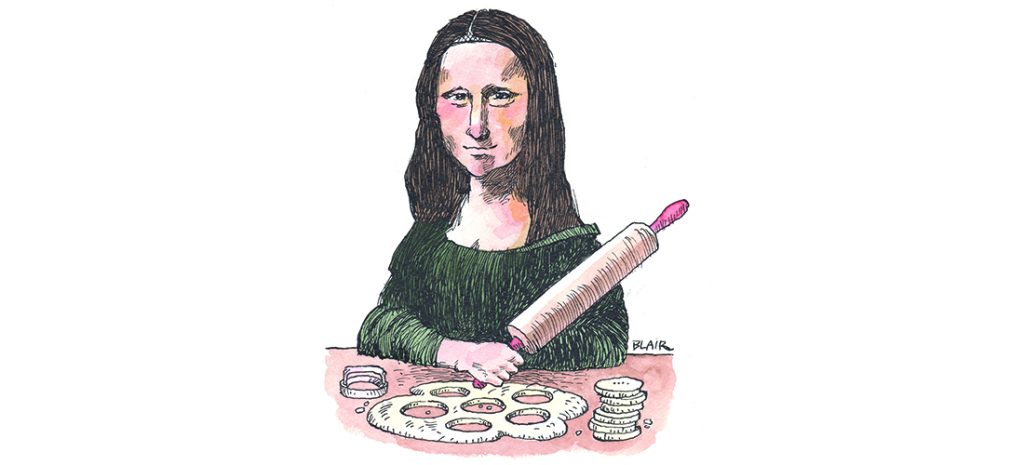O.Henry Ending

La Mona Lisa Gioconda
Value is in the eye of the beholder
By: Cynthia Adams
I have a not-so-secret fascination with Mona. Mona and I go way back.
The Italians call the Florentine beauty La Mona Lisa Gioconda — Madam Lisa Giocondo. She is La Joconde to the French.
As Nat King Cole crooned, she is Mona Lisa to the rest of us.
My first reproduction of Mona was set in a chippy frame beneath wavy glass. This prized possession cost $1 at the former Sedgefield Flea Market.
More recently, I’ve acquired others: two oversized giclées by Randy Slack titled Mona Ghost and Mona Citrus. I own books on the infamous Louvre thefts and tussles over the world’s most famous portrait, replete with accounts of when she went missing or was subjected to unwarranted attack. Five times and counting, Mona has been either outright stolen (the first time in 1911) or vandalized. Rocks, tea cups and paint have been hurled at the impassive face
Why all this drama? Salvador Dali said Mona with the mystic smile had “a power, unique in all art history, to provoke the most violent and different kinds of aggressions.”
Recently, a film critic reviewing Glass Onion suggested that Mona symbolizes legacy. The villain in the film “wants to be remembered in the same breath as the Mona Lisa . . . standing the test of time.”
Her legacy was burnished with every assault, Mona’s fame escalating after the 1911 heist.
She epitomized Da Vinci’s greatness. No visible brush strokes. The lifelike countenance. Mona’s ambiguous physicality. And . . . that smile. We experience Mona as faintly masculine, lacking eyebrows or lashes (overzealous restoration removed them).
Da Vinci began the commission of Mona, the wife of a wealthy Italian merchant Francesco del Giocondo, in 1503. He worked on it until 1507.
When he left Italy on horseback for France in 1516 at the invitation of an admiring King Francis I, he took Mona’s portrait with him.
Installed by Francis at the Château du Clos Lucé in Amboise, he hung Mona on his bedroom wall.
He himself regarded her as his opus. (Or not; an art dealer earlier this year argued this: what if the artist wanted to hide her?) Mona held his attention because he never considered her quite finished.
Working in splendid style befitting a genius, he died at age 67 in 1519 in the arms of the weeping King, who called Da Vinci “Father.”
It is entirely possible that Mona’s was the last face he saw at his death.
Afterward, Da Vinci’s painting was claimed by the French King much to the consternation of the Italians. The Chateau was preserved by the French as a Da Vinci Museum.
The embittered Italians want her returned. When first stolen from the Louvre by an ordinary workman in 1911, she was whisked off to Italy.
Mona became an international celebrity. You get the picture: Cabbages and kings alike obsessed over Mona.
I placed Dollar Mona, the chippy, cheap one, over the kitchen stove. There was and is something inspiring about Mona’s presence.
House-poor as we were, Mona somehow sustained our determination to revive and make worthy the tatty kitchen.
We scraped, painted, plastered and sweated over the monstrous job we faced. We fashioned new cabinet doors and tiled the counters. Too poor to replace the ancient stove, we polished till it gleamed.
My brother showed up one weekend to reinforce the sagging dining room floor. Slowly, the careworn, early-1900s house responded.
Feeling celebratory, we opened it up for a party. A niece’s ex, famously befuddled, disappeared into the kitchen for an inordinate amount of time.
What the heck was he doing?
Walking through the butler’s pantry to the kitchen, I overheard as he ground out the words, “That’s the Mona Lisa,” stopping me in my tracks.
“Yeah, I know,” replied my niece.
“Well, they’ve got to have money if they own that,” he said sourly.
Wearing an enigmatic smile of my own, I reversed course and rejoined the party. True enough, even Dollar Mona had grown beyond price. OH
